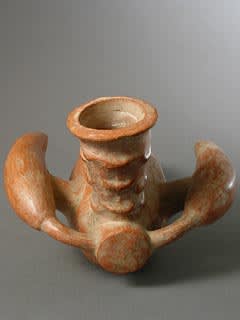Moche Vessel in the Form of a Fruit, 1 CE - 600 CE
Terracotta
K.077
Further images
In many places in the Americas, yucca, not maize, was the staple food. The plant has clustered roots ending in elongated tubers. It is easy to grow; it does well...
In many places in the Americas, yucca, not maize, was the staple food. The plant has clustered roots ending in elongated tubers. It is easy to grow; it does well in environments not suitable for maize cultivation; and it can be utilized in multiple ways. Eaten frequently in various forms in the tropics today, the plant is perhaps best known in the United States in the form of tapioca. The shape of the yucca makes a handsome bottle. The sculptor of this vessel has carefully balanced the naturalistic form of the yucca plant with the functional shape of the container. The wood-like stalk projects from the front of the vessel and serves as a spout. Perhaps a cap that would fit easily into the stalk contained the contents of this vessel. One enlarged, hollow yucca serves as the body of the vessel. Three smaller tubers are connected to the stalk, functioning as handles. The form of this vessel is simultaneously evocative of the reed bundle boats that were commonplace in ancient Peru. This unassuming vessel is a masterpiece of naturalistic manipulation. The artist has taken a form existing in nature and subtly molded and twisted it to create a functional container that is clearly based on the yucca but also suggests something as vastly different as a boat. The significance of the sea to Ancient Peruvians was probably only outranked by the importance of agricultural sustenance. Thus this vessel is suggestive of the greater idea of life and survival.







